Revival of Christian heritage in Karabakh by Azerbaijan – exemplary respect and tolerance Exposing Armenian accusations and falsifications
The heritage of all religions in the liberated lands of Azerbaijan, which suffered collateral damages, destruction, and pillage has been at the centre of the Azerbaijani government’s attention since the end of the war with Armenia in 2020. The post-war checks and surveys revealed grave outcomes of the Armenian occupation in the churches, monasteries, mosques, chapels and more.
Although the Armenian authorities have been ardently trying to put the blame on the Azerbaijani side for the inhuman approach toward the religious sites, in particular Christian monuments, in those lands, the post-liberation activities of Baku proved everything to be vice-versa.
The government of Azerbaijan has been taking a sensitive and responsible approach toward the legacy of all religions, including Christian landmarks in the territories liberated from the Armenian occupation. The activities of the country’s authorities so far have been a strong argument to fundamentally deny Armenian accusations of the so-called destruction of the Christian heritage.
It took no time for Baku after ending the 2020 war with Armenia in a complete victory to draft several action plans aimed at rehabilitating historical, cultural, and religious monuments in the liberated lands. Almost all monuments in these lands, including in the Karabakh region, suffered seriously from Armenian vandalism during the nearly 30-year-long illegal Armenian occupation, and the Christian temples and churches could not escape vandalistic acts, as well.
During his visits to the liberated districts, President Ilham Aliyev personally exposed the traces of the cultural savageness committed by Armenians in multiple Christian temples.
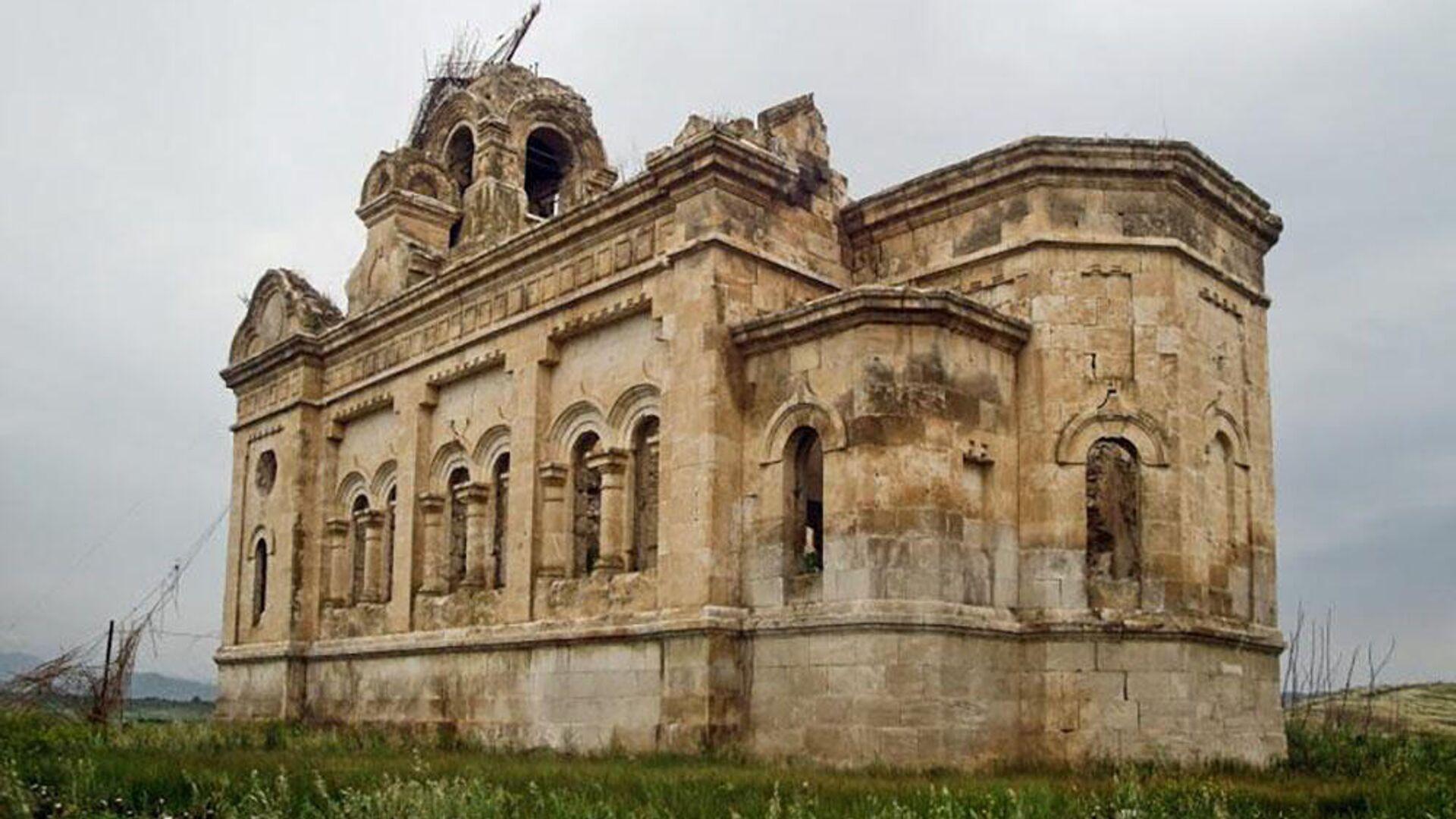
A Russian Orthodox Church that was destroyed by Armenians in Khojavand
“Armenianization”
Armenians claim all the Christian monuments in the Caucasus, including those in the Karabakh region of Azerbaijan belong to them although even the Armenian authors acknowledge that Christian Kipchaks (a Turkic tribe) and Christian Albanians (people of Caucasian Albania – a mediaeval state existed in the territory of modern-day Azerbaijan) had also lived in this region. The denial of the presence of Christian Turks and Albanians across these territories makes part of Armenian efforts to reject the religious heritage of the true owners for the sake of “cementing” the highly arguable “indigenous roots" of Armenians in the region.
The “Armenianization” policy has traditionally been accompanied by the destruction of original signs and elements for expediting the falsification of religious monuments of other people. Renowned Austrian scholar Erich Feigl mentioned in his book “Armenian Mythomania” of misappropriation of others’ religious heritage under the patronage of the Armenian religious leadership in greater geography.
For instance, an ancient Albanian temple in the Hunarli village of the Khojavand district, the White Cross temple near the Hadrut settlement, and the Blessed Virgin Mary Church, also located in the Khojavand district in Karabakh, were desecrated and deliberately refashioned as “Armenian churches.” Armenians almost completely destroyed a Russian Orthodox church in Khojavand during the decades of occupation. The Russian Gazanchi church in the city of Shusha and the Albanian temples such as the Beshikdagh church in the Aghdam district, the Ganjasar and Khudavang monastery complexes in Kalbajar, the Aghoghlan temple in Lachin, the Holy Elysee temple complex in Aghdara, and some other monuments of the Albanian heritage have also been exposed to cultural vandalism and “Armenianization” policy conducted by Armenians during the decades of illegal occupation.
One of the crystal-clear proofs of how Armenians have enthusiastically engaged in marking the Azerbaijani lands as “ancient Armenian territories” was seen in the city of Lachin after Azerbaijan regained its control on August 26 of this year. An “ancient Armenian church” in the city was revealed to be a new building built by Armenians in 1996-98. Lachin resident Gubad Ibrahimov has exposed the Armenian falsification with solid photo facts and documents, which proved the church to be established in the place of his private house in Lachin at Azi Aslanov Street, 35.
In a letter submitted by the Azerbaijani government to the UN in 2021, Armenia was said to use a modern workshop for the production of "ancient" khachkars - Armenian cross-stones that were discovered in Azerbaijan's liberated Kalbajar region. The workshop churned out artificially antiquated religious elements to add to churches and temples, as well as the same-styled construction materials to make new buildings look “ancient”.
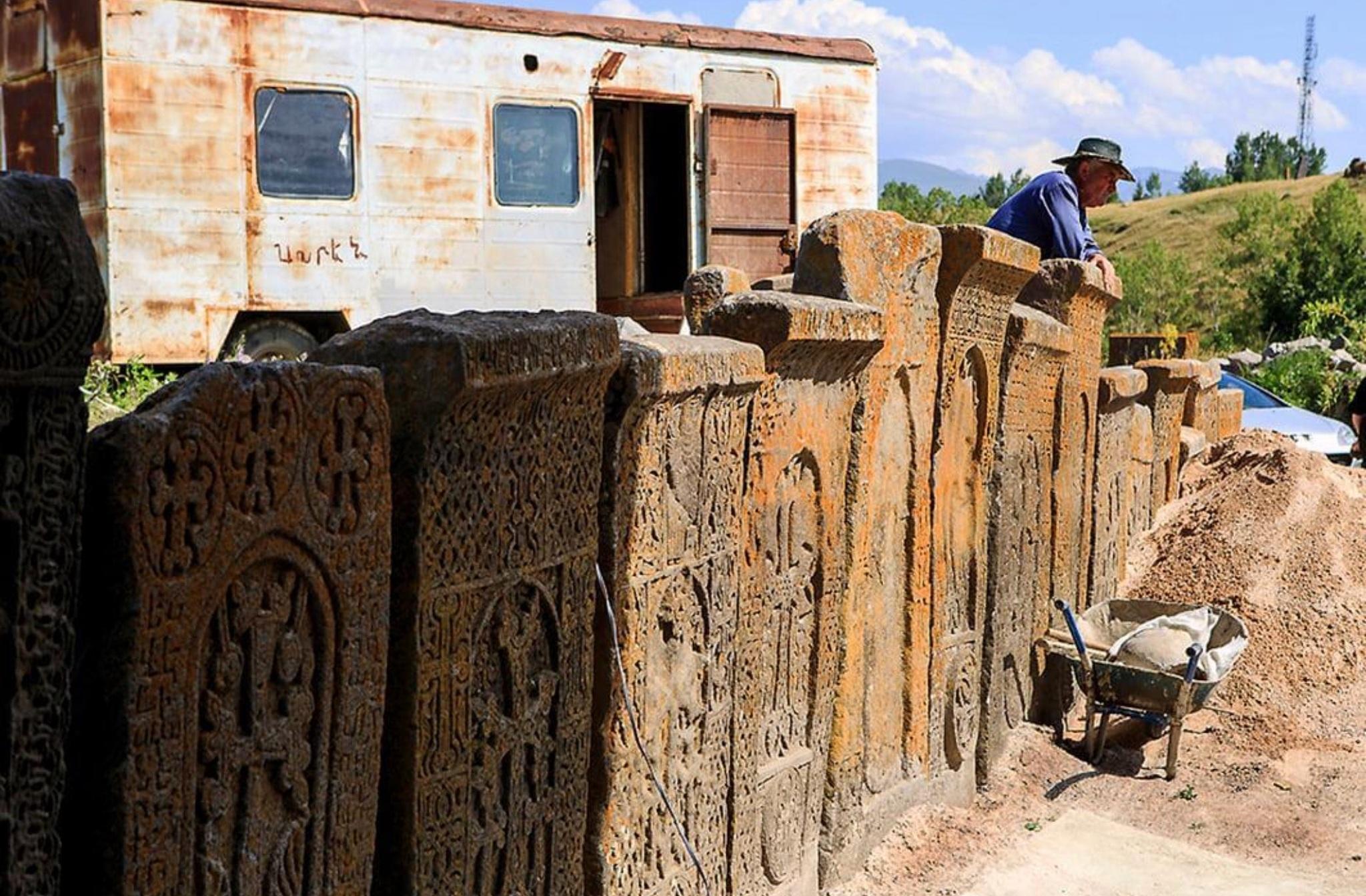
An Armenian workshop that churns out "ancient Armenian khachkars" and makes new buildings "look older"
“These khachkars were oxidized and vinegar was used in the process of artificial ageing and then they were buried as 'indisputable evidence' of 'centuries-old Armenian roots' in this region," the letter said.
The “Armenianization” and “Gregorianization” of the Christian heritage of Azerbaijan are a grave violation of the Hauge Convention for the Protection of Cultural Property in the Event of Armed Conflict 1954, the European Convention on the Protection of the Archaeological Heritage 1992, and the UNESCO World Heritage Convention 1972.
Rehabilitation of Christian heritage
According to data compiled by the Azerbaijani government, the total number of state-registered historical and cultural monuments in the liberated territories is more than 900, including 403 historical and religious monuments: 67 mosques, 144 churches, and 192 sanctuaries.
Azerbaijan’s Culture Ministry inscribed all Christian monuments in the Karabakh region in the list of monuments of national importance and supported the state-run campaign to restore the religious heritage in the liberated lands. On November 14, 2020, President Aliyev said Azerbaijan would properly protect the Christian temples located in the liberated territories, and Christians living in the country would be able to use these temples.
The Gazanchi Church in the liberated city of Shusha can be listed as one of the buildings being restored as an example of the Christian heritage of Azerbaijan. The restoration blueprint of the church was developed based on its original architectural image. Another example is the St. John the Baptist Russian Orthodox church in Shusha, which is also set to regain its historical appearance altered by Armenians. During the illegal Armenian occupation, the original dome-shaped roof of the temple, which is typical of Russian architecture, has been replaced with a conical dome in order to remodel the building as an “Armenian church.”
Gazanchi Church in Shusha, Karabakh is being restored by the Azerbaijani government
In December 2020, Rafik Danakari, a preacher from the Albanian-Udi community of Azerbaijan was appointed to the ancient Albanian monastery complex Khudavang located in the Kalbajar district of Azerbaijan and led the first prayer ceremony for the Albanian-Udi community in the temple. Before leaving Kalbajar in November 2020, Armenians ransacked the Khudavang temple causing serious damage after sacred items such as church bells and stones, artefacts, and portraits have been looted. Armenians have then confessed that they had not intended “to leave anything to Muslims" in Kalbajar, including the religious monuments that already belonged to the Azerbaijani residents of the district.
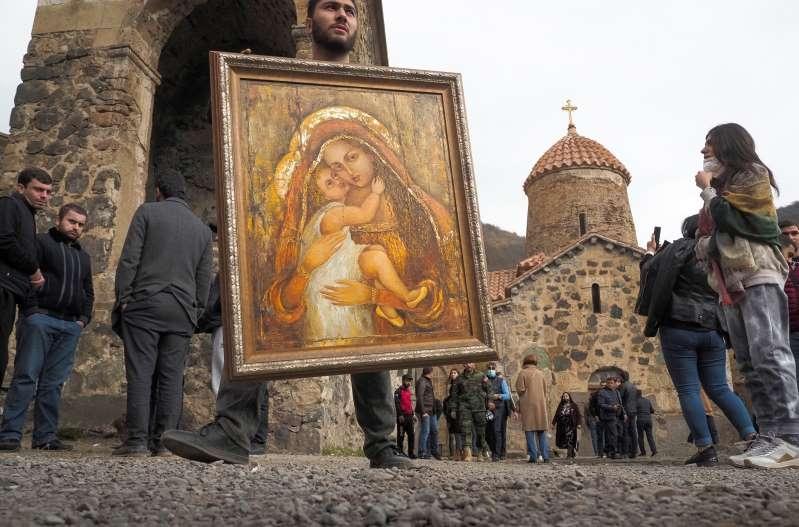
Armenians looting the Albanian Udi Khudavang monastery before leaving Kalbajar, Azerbaijan
Khudavang or Dedeveng monastery was built in the VIII-XIII centuries during the reign of the ancient Azerbaijani state of Caucasian Albania that was founded sometime before the 6th century BC and lasted until the 8th century AD. Christianity was the major religious belief in this ancient state, which has no relation to modern-day Albania in the Balkans. Khudavang is one of the largest and most complete examples of Azerbaijan’s Christian heritage. The names such as Arzu, Tursun, Seyti, Hasan, Avag, Shams, Altun, Aghbuh, and Garagoz, which are seen in numerous construction inscriptions in the Khudavang monastery, prove the Turkic identity of its founders.
Azerbaijan has been rehabilitating the monuments of the Christian heritage in the Karabakh region as the legacy of Caucasian Albania and the estate of the Russian Orthodoxy and submitting fact-based rejections to its so-called belonging to the Armenian Gregorian Church.
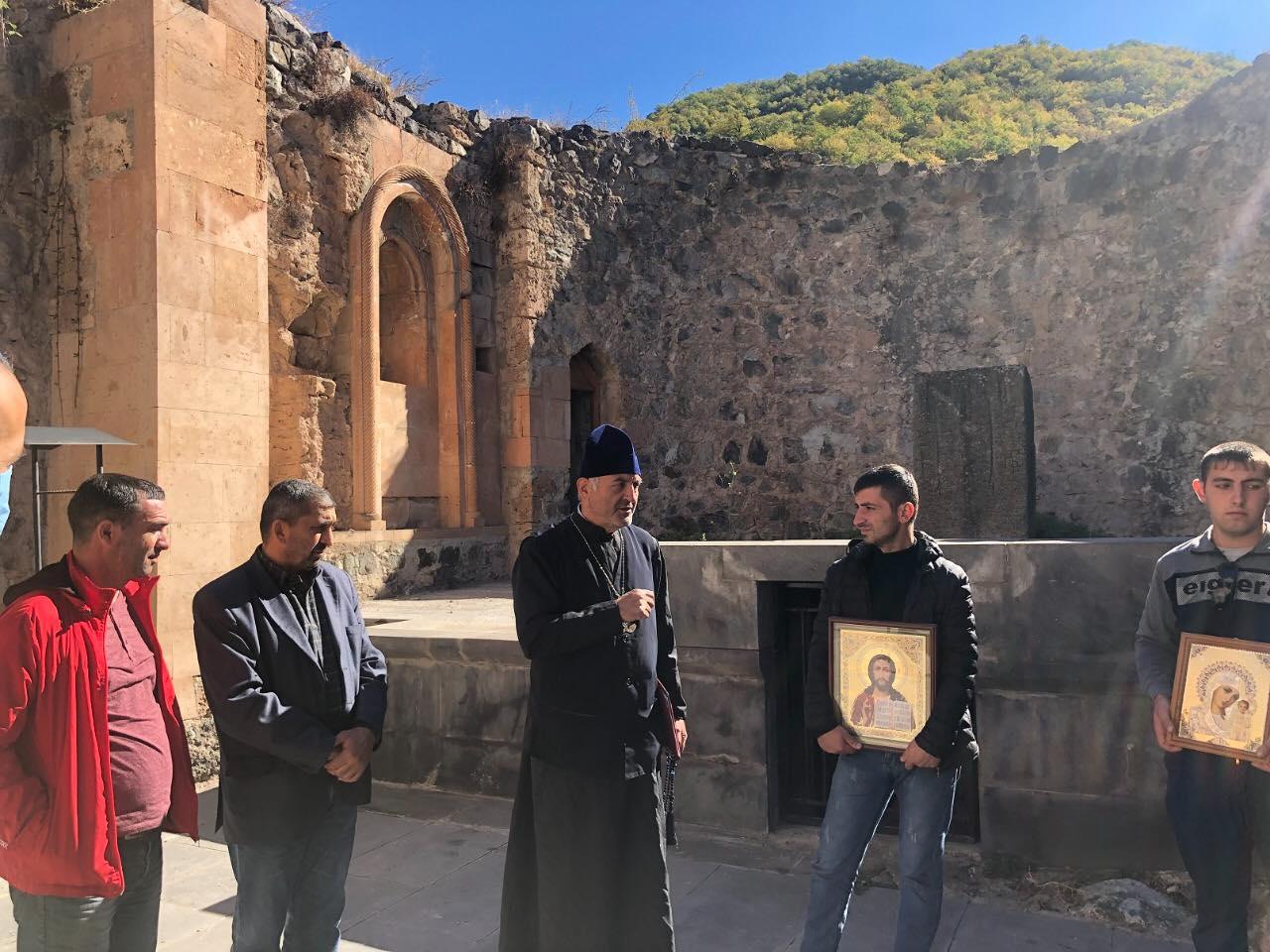
Members of the Albanian Udi Community of Azerbaijan at the Khudavang monastery in Kalbajar, Azerbaijan
According to data compiled by the Azerbaijani government, prior to the occupation of the Karabakh region by Armenia, there were 128 Albanian temples and monasteries and three Orthodox temples.
Udis living primarily in the northern Gabala and Oghuz regions of Azerbaijan are direct descendants of Caucasian Albania. There are two Albanian temples in the village of Gabala. A total of more than 4,000 Udis, the world’s largest population of this minority, are settled in Azerbaijan, including in Gabala, Oghuz, Baku, and Sumgait. Russia, Georgia, Uzbekistan, and Kazakhstan are also home to groups of Udis.
The Azerbaijani Albanian-Udi religious community succeeded the Albanian (Caucasian) Independent Apostolic Church. The Albanian Apostolic Church, as the first apostolic church in the Caucasus, has a long history and has left indelible marks on the religious and cultural life of the people of Azerbaijan and the entire Caucasus. However, after various pressures and influences, the Albanian Apostolic Church was abolished by the Russian empire in 1836. The invalidation of the church paved the way for the Armenian-Gregorian church to claim part of its cultural and spiritual heritage for the purpose of “Gregorianization.”
“Ying and Yang”
Religious sites and monuments, wherever they are located and whichever religion they belong to, are considered the heritage of humanity, but a certain group of people. It is a fundamental rule of humanism to be guided by respect and tolerance for the heritage of all religions. Azerbaijan, as the world’s exemplary multi-faith country, where Muslims, Christians, Jews and members of other religions live in a unique co-existence, has been long acclaimed for its equal approach toward all religious beliefs. Three per cent of Azerbaijan’s population are Christian; less than 0.2 per cent are Jews, and 0.2 per cent are either unaffiliated with any religion or belong to minority religious groups. Currently, more than 2,000 mosques, 14 churches, and seven synagogues are operating across the Caspian region country. An Armenian church with an Armenian library is also preserved in the capital Baku.

An Armenian church that is preserved by the Azerbaijani government in the very centre of the capital Baku
However, the same cannot be said about Armenia given the solid facts of how this mono-ethnic country is not able to tolerate the legacy of other nations within its territory. A report by Caliber.Az from Armenia’s capital Yerevan has recently demonstrated the outcomes of the Armenian vandalism against the legacy of Azerbaijanis in the city – almost all cultural and religious monuments were either falsified, Armenianized or completely annihilated. In addition, the mosques in the once occupied Azerbaijani territories have been seen either looted, destroyed or transformed into pig barns in a deliberate attempt to desecrate the values of Islam by keeping an animal, which was recognized as haram for Muslims, in sacred places.
So, can you now realize who is good and who is evil? Worth to remind that good always wins over evil, as Azerbaijan did in the 44-day war in 2020 …
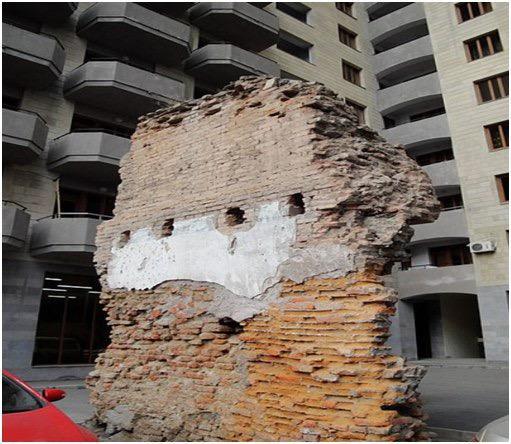
The last remaining piece of the Sardar Mosque of Azerbaijanis in Armenia's capital Yerevan (historical Iravan city of Azerbaijan). It was seen a few years ago but later disappeared within the huge residential complex








